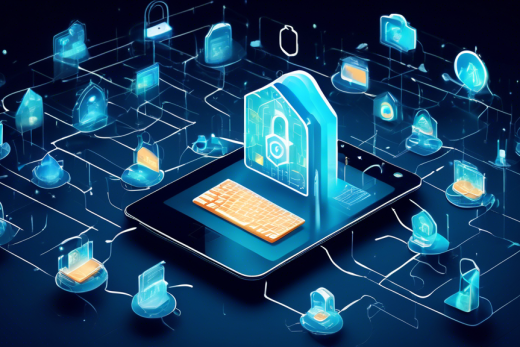How to Delete My Personal Information Online: A Comprehensive Guide
Understanding the Importance of Data Privacy and When to Delete Personal Information
In an increasingly digital world, maintaining control over your personal data is more important than ever. Personal information refers to any data that can identify you, such as your name, address, social security number, phone number, and even online activity. The ability to delete my personal information online is becoming crucial due to various privacy concerns.
Privacy concerns range from identity theft to online harassment, and there are legal frameworks like the General Data Protection Regulation (GDPR) and California Consumer Privacy Act (CCPA) designed to protect individuals. Understanding when it’s necessary to remove your data—especially in scenarios involving identity theft, doxxing, or unauthorized data sharing—can help safeguard your privacy and ensure your safety.
Step-by-Step Process to Delete Personal Information from Various Platforms
Removing your personal information from the internet can be a daunting task, but it’s achievable with a systematic approach. This section provides a detailed guide to deleting your data from popular social media platforms like Facebook, Twitter, and Instagram, as well as instructions for erasing information from search engines and data broker sites. You’ll also find methods to contact and request data removal from online directories and public records.
Tools and Services to Help You Delete Personal Information Online Effectively
To make the process of deleting your personal information online more efficient, there are several tools and services available. This section reviews online privacy tools and software such as DeleteMe and PrivacyDuck, providing a comparison of paid versus free services for data removal. You’ll also receive actionable tips for maintaining ongoing online privacy and monitoring for future data breaches to ensure your personal information remains secure.
Understanding the Importance of Data Privacy and When to Delete Personal Information
Explanation of Personal Data and Privacy Concerns
In today’s digital age, understanding the importance of data privacy is more critical than ever. Personal data encompasses any information that can identify an individual, such as names, email addresses, phone numbers, and even IP addresses. This information is invaluable to businesses, as it allows them to tailor their services and marketing strategies to individual preferences. However, it also presents a risk when mishandled or exposed without proper safeguards.
Privacy concerns arise when personal data is collected, stored, or shared without the individual’s consent. The rampant growth of data-driven technologies has made it easier for unauthorized entities to access and misuse personal information. This has resulted in various threats, such as identity theft, financial fraud, and unwarranted surveillance. As such, it becomes imperative to understand when and how to delete personal information online to mitigate potential risks.
Legal Implications and Regulations
Data privacy is not just a personal concern; it has significant legal implications as well. Various regulations have been implemented worldwide to safeguard individuals’ personal information. Two of the most prominent laws are the General Data Protection Regulation (GDPR) and the California Consumer Privacy Act (CCPA).
GDPR: Enacted in 2018, the GDPR is a regulation in the European Union that gives individuals greater control over their personal data. It mandates that organizations must obtain explicit consent before collecting personal data and provides individuals with the right to access, rectify, and delete their data.
CCPA: Effective from January 2020, the CCPA is designed to enhance privacy rights and consumer protection for residents of California. It grants consumers the right to know what personal data is being collected, to whom it is sold, and to request the deletion of their data.
Both of these regulations, among others, highlight the importance of data privacy and the need for individuals to be proactive in managing their personal information online. Failure to comply with these laws can lead to severe penalties for organizations and significant harm to individuals.
Scenarios That Necessitate Data Removal
There are several scenarios where it becomes crucial to delete personal information online. Recognizing these situations can help individuals take prompt action to protect their privacy.
- Identity Theft: One of the most alarming reasons to delete personal information online is identity theft. Cybercriminals can use stolen data to commit financial fraud, create fake identities, and even engage in illegal activities. By removing personal information from online platforms, individuals can reduce the risk of becoming victims of identity theft.
- Online Harassment: In cases of online harassment or cyberbullying, it is essential to delete personal information to safeguard one’s mental health and well-being. Cyberbullies can exploit private data to further their harassment campaigns, making it vital to minimize the availability of such information.
- Data Breaches: When an organization experiences a data breach, the exposed personal information can be misused by malicious actors. In such instances, individuals should take steps to delete or secure their data to prevent potential exploitation.
- Unwanted Marketing: Unsolicited marketing and spam can clutter inboxes and interrupt daily life. Removing personal information from marketing databases and opting out of subscription lists can help mitigate this issue.
Understanding the reasons and processes for deleting personal information online empowers individuals to take control of their digital footprint. In the following sections, we will provide a detailed guide on how to remove data from various platforms and highlight tools and services to assist in this crucial task.
How to Delete My Personal Information Online: A Comprehensive Guide
Step-by-Step Process to Delete Personal Information from Various Platforms
In today’s digital age, knowing how to delete your personal information online is crucial for maintaining privacy and security. Unfortunately, the process can be complex due to the numerous platforms and databases that might hold your data. Here, we provide a step-by-step guide to help you effectively remove personal information from key areas of the internet.
Removing Data from Social Media
Facebook is one of the most common platforms where personal information is shared. To delete your data:
- Go to your Facebook account settings.
- Click on Your Facebook Information.
- Select Delete Your Account and Information at the bottom of the page.
- Follow the prompts to confirm your decision.
Remember, Facebook provides a 30-day grace period during which you can cancel the deletion request if you change your mind.
Twitter allows you to delete tweets individually or deactivate your account entirely:
- To delete individual tweets, click on the down arrow icon on the tweet you want to remove and select Delete Tweet.
- To deactivate your account, go to Settings and Privacy, click on Your Account, then Deactivate Your Account.
- Follow the instructions to confirm deactivation. Your data will be deleted after 30 days of inactivity.
To delete your Instagram account:
- Log in via a web browser (you cannot delete your account from the app).
- Go to the Delete Your Account page.
- Select a reason for deleting the account from the dropdown menu.
- Re-enter your password and click Permanently delete my account.
Removing Information from Search Engines and Data Broker Sites
Although it’s hard to completely erase your existence from Google, you can remove specific URLs:
- Use the Google Removal Tool to request the removal of URLs containing personal information.
- Submit the URL and the reason for removal.
- Monitor the status of your request through the provided interface.
Data Broker Sites
Data brokers collect and sell personal information. Popular data broker sites include Whitepages, Spokeo, and MyLife. To request removal:
- Visit the website’s opt-out page. This usually involves searching for your profile and confirming your identity.
- Submit a request for removal and follow any additional instructions they provide, such as verifying your identity via email or phone.
Contacting Online Directories and Public Records
Online directories and public records can also store personal information, such as address and phone number. Here’s how to proceed:
Online Directories
For directories like Yellow Pages or SuperPages:
- Locate your listing by searching the directory website.
- Contact their support team via email or phone to request the removal of the listing.
- Provide any required details to confirm your identity and authorize the removal.
Public Records
Public records are a bit more challenging. You may need to contact government agencies directly:
- Identify the specific public records containing your information, which could include voter registrations, property records, or court documents.
- Reach out to the office that maintains those records (e.g., county clerk, registrar of voters) and inquire about their removal procedures.
- Submit a formal request, which sometimes requires legal documents or petitions.
While some public records are mandatory by law and cannot be removed, many agencies will be willing to review your request, especially if it involves sensitive information.
By following these steps, you can take significant measures to delete your personal information online, helping to safeguard your privacy and reduce the risk of identity theft and other forms of cybercrime. Stay proactive in monitoring your online presence and use these strategies as part of your ongoing data privacy efforts.
Tools and Services to Help You Delete Personal Information Online Effectively
Review of Online Privacy Tools and Software
As you navigate the journey to delete my personal information online, leveraging dedicated privacy tools and software can make the process significantly more manageable and efficient. Several robust services are designed specifically to aid in the removal of your personal information from the web, providing peace of mind and enhanced security.
One notable tool is DeleteMe. This service specializes in locating and removing your information from a multitude of data broker websites. It offers a subscription model where you can opt for various plans based on your needs. DeleteMe also provides regular updates and reports to keep you informed about the status of your data removal efforts, ensuring continuous monitoring and protection.
PrivacyDuck is another premium service that excels in privacy protection. PrivacyDuck emphasizes a hands-on approach, offering personalized services from privacy experts who manually remove your information from risky online platforms. While it is a higher-end option in terms of cost, the individualized attention and thoroughness can be highly beneficial, particularly for those with sensitive or extensive online data footprints.
Additionally, tools like Incogni and Removaly provide varying levels of protection and capabilities, from automated data removal to comprehensive monitoring services. Evaluating the specific features, customer support, and effectiveness of these tools will help you choose the best option tailored to your specific privacy needs.
Comparison of Paid vs. Free Services for Data Removal
When looking to delete my personal information online, you will encounter both free and paid services. Understanding the advantages and limitations of each can help you make an informed decision on which route to take.
Paid Services: These typically offer more comprehensive and reliable results. Paid services like DeleteMe and PrivacyDuck provide ongoing monitoring, regular updates, and broader coverage of various data sources. They often include customer support and personalized assistance, which can be crucial for handling complicated scenarios or specialized needs. While the subscription fees might be a factor to consider, the robustness and peace of mind they offer tend to justify the investment for many users.
Free Services: On the other hand, free tools often come with limitations. They might only cover basic data removal processes or offer a limited number of removal requests. Services like Google’s Remove Outdated Content tool or manual opt-out processes from individual data broker websites can be used without cost but require more effort and time. Users might have to do much of the legwork themselves, including continuous follow-up to ensure that the data is effectively removed.
In conclusion, while free tools can be a good starting point, paid services generally provide a more thorough and streamlined approach to delete my personal information online. Evaluating your individual privacy requirements, budget, and the level of effort you’re willing to invest will help you determine the best course of action.
Tips for Maintaining Ongoing Online Privacy and Monitoring for Future Data Breaches
Successfully navigating the process to delete my personal information online is a significant first step, but ongoing vigilance is crucial to maintain your privacy. Here are some actionable tips to help you safeguard your personal data continually:
- Regularly Update Privacy Settings: Frequently review and adjust privacy settings on social media platforms, online accounts, and services. Limiting the amount of personal information shared publicly helps mitigate future risks.
- Use Strong, Unique Passwords: Employ strong passwords and consider using a password manager to keep track of them. Avoid reusing passwords across multiple accounts.
- Enable Two-Factor Authentication (2FA): Adding an extra layer of security by enabling 2FA can prevent unauthorized access to your online accounts even if your password is compromised.
- Monitor Your Online Presence: Regularly perform searches for your name and personal details to identify where your information might be publicly accessible. Services like Google Alerts can notify you of new appearances of your personal information.
- Stay Informed About Data Breaches: Subscribe to alerts and reports on data breaches from services like Have I Been Pwned. Promptly change your passwords and take necessary actions if you’re affected by a breach.
- Limit Data Sharing: Be cautious about the amount of personal information you share online. Avoid posting sensitive data on social media and think twice before sharing personal details on unfamiliar websites.
By utilizing effective tools and services, making informed decisions between paid and free options, and adopting ongoing privacy practices, you can maintain a robust defense against unauthorized access and ensure that your efforts to delete my personal information online remain effective over the long term.
Conclusion
In the ever-evolving digital landscape, understanding the importance of data privacy and knowing when and how to delete your personal information online is crucial. With the alarming rise in identity theft, online harassment, and other privacy concerns, taking active steps to protect your personal data has never been more important. This comprehensive guide has walked you through the essential processes, from understanding the significance of data privacy and recognizing scenarios that necessitate data removal to executing the step-by-step deletion of your information from various platforms and leveraging specialized tools and services.
By being proactive and methodical in managing your online presence, you can significantly reduce your vulnerability to myriad digital threats. While deleting your personal information online may seem like a daunting task, the right knowledge and resources make it feasible and effective. Embrace these best practices not only to safeguard your personal data now but also to ensure ongoing privacy and peace of mind in the future. Your online privacy is worth the effort, and with the guidance provided, you’re well-equipped to take control of your digital footprint effectively.



